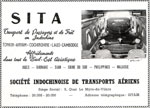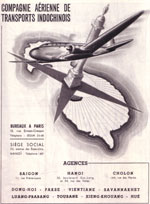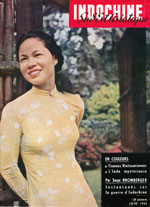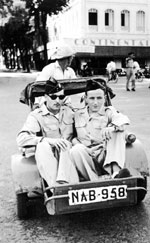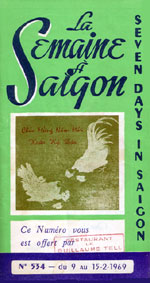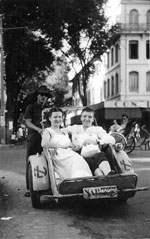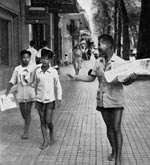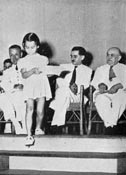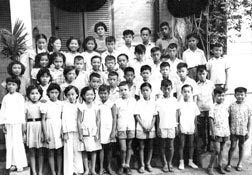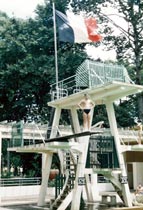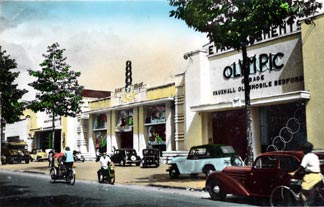

The Plateau
The Plateau dominates the rest of the city by several meters. It is located after Norodom Boulevard behind Notre Dame Cathedral. It is here that one finds the very exclusive "Cercle Sportif" club as well as the residences of leading colonial citizens of Cochin China and the Pasteur Institute.
Chasseloup-Laubat Street
in 1955 Hông Thâp Tu (Red Cross)
now Thi Minh Khai
Justin Napoleon Samuel Prosper, Marquis of Chasseloup-Laubat (1805-1873) was Minister of the Navy and of the Colonies from November 24th, 1860 to 1869. He founded the Protectorate of Cambodia and completed the conquest of Cochin-China.
Appointed by Emperor Napoleon III, he served as Minister overseeing the State Council for the establishment of the âLiberal Empireâ.
Chasseloup-Laubat Street is one of the longest in the city of Saigon. It begins in the north at the bridge of Arroyo de lâAvalanche (Avalanche Creek) (Thi Nghè), runs along the Saigon Botanical Gardens, crosses the width of the city and ends at the line between Saigon and Cholon. In going through the central part of the city, the street borders on one side of the old Governor Generalâs Palace, now the Palace of Independence. It also passes in front of the Collège Chasseloup-Laubat, a high school built in 1875.

The Chasseloup-Laubat High School
Chasseloup-Laubat High School
110, Chasseloup-Laubat Street
Saigon
Tel: 20.021
This establishment was founded on November 14th, 1874, with the name of âNative High-Schoolâ, which was set up to train young Cochin-Chinese professionals for the administration of the Colonies. After its merger with Adran high school in 1891, young French students were admitted. In 1928 it became Chasseloup-Laubat high school, and the curriculum was taught solely in the French language.

The Chasseloup-Laubat High School
On July 14th, 1942, Admiral Jean Decoux gave a speech in which he associated the Vietnamese youth with the National Revolution advocated by the Vichy Government.
Closed on February 7th, 1945, during the Japanese occupation, the school was used as a reception center for refugees from Indochina and was pillaged.
The school progressively reopened all its classrooms during the 1945-46 school year welcoming French and Vietnamese students. In 1946 it became a coeducational school. However, as of the opening of the Marie Curie High School for girls in 1947 (formerly the Calmette School), located at 159 General de Gaulle Street (in 1955 CĂ´ng Ly, and now Nam Ky Khoi Nghia) in Saigon, the female element disappeared from Chasseloup-Laubat.
On July 11th, 1951, a few months before his death, General Jean de Lattre de Tassigny appealed to the young Vietnamese at the high-school:
"Vietnam will be saved by you. Young men of the Vietnamese elite to whom I feel as attached as to the youth of the land of my birth, the moment has come for you to defend your country. Sweat and blood are still necessary to raise the harvest of free men under the sun of independence. The intellectual youth of Vietnam has its place today in this great task, alongside the peasant youth. I have confidence in you. You are the hope that has not faltered and will not be disappointed. I believe that the World will be saved by a few. I believe that Vietnam will be saved by you.".
Well-known people having attended Chasseloup-Laubat include:
- at the beginning of the 20th century, General Nguyên Van Xuân.
- at the same period, the journalist NguyĂŞn Van Tao, who would be expelled from Chasseloup-Laubat.
- the brilliant student, Ta Tu Thau, who would go on the study at university in France, who had Trotskyite leanings and would be assassinated by the Vietminh in 1945.
- in 1930, Marguerite Duras, (penâname of French author and playwright Marguerite Donnadieu) would study at Chasseloup-Laubat and received her degree there.
At the end of the â30âs, it would be Prince Norodom Sihanouk of Cambodiaâs turn.
On June 17th, 1955, the solemn awarding of prizes took place under the presidency of NgĂ´-Dinh-DiĂŞm, president of the Vietnamese government. (He would be assassinated during a coup dâĂŠtat on November 2nd, 1963).
On June 26th, 1956, the solemn awarding of prizes took place under the presidency of NguyĂŞn-Duong-Don, Secretary of State for National Education of Vietnam. (At the end of the 1950âs he would be Ambassador of South Vietnam in Rome).

Jean-Jacques Rousseau College
In 1960 the Chasseloup-Laubat High School changed its name to break the tie that linked it to the French Colonial Empire; it would be known as the Jean-Jacques Rousseau School (philosopher of values reputed to be universal).
At the beginning of the 1970âs the school was turned over to the South-Vietnamese government and changed its name to become LĂŞ QuĂ˝ DĂ´n, after an 18th century Vietnamese man of letters.
After the fall of the South-Vietnamese government in April 1975 it kept the same name: LĂŞ QuĂ˝ DĂ´n General Second Degree Education Establishment.

The Marie Curie High School
Marie Curie High School
159, General de Gaulle Street (in 1955 CĂ´ng Ly and now Nam Ky Khoi Nghia)
Tel: 20.625
Opening of the Marie Curie High School for girls in 1947.
La Boule Gauloise
37, Chasseloup-Laubat Street
The Colonial Circle was founded in 1863 and became later the "La Boule Gauloise" sports circle.
Le Cercle Sportif Saigonnais (The Saigon Sports Circle)
C.S.S.

The Saigon Sports Circle (Athletic Club)
55, Chasseloup-Laubat Street
Saigon
Tel : 20.385
Bar : 20.288

Bienhoa Forests & Sawmills
62, Chasseloup-Laubat Street
The Olympic Company
95-97-99, Chasseloup Labat Street
Saigon
Tel: 20.935
Cars: Oldsmobile, Vauxhall, Salmson
Trucks: Diamond T, Denis, Bedford
Motorcycles: Harley-Davidson, Triumph, Jawa, Ogar
Chairmen: MM. Nguyen Thanh Co & Nguyen Van Nhon
Olympic Theater and Garage
Different departments: Importations, Garage, Station-Service, CinĂŠma.
The Olympic Company in 1960
In 1955 Chasseloup Labat will become Hông Thâp Tu

Offices of the Saigon Michelin tire manufacturing company



180, Chasseloup Labat Street
Saigon
Tel: 22.122

A big thank-you to RenĂŠ Poizat for the photos and documents from his personal collection.
Photos of Chasseloup Laubat High School come from the National Overseas Archives in Aix en Provence.













